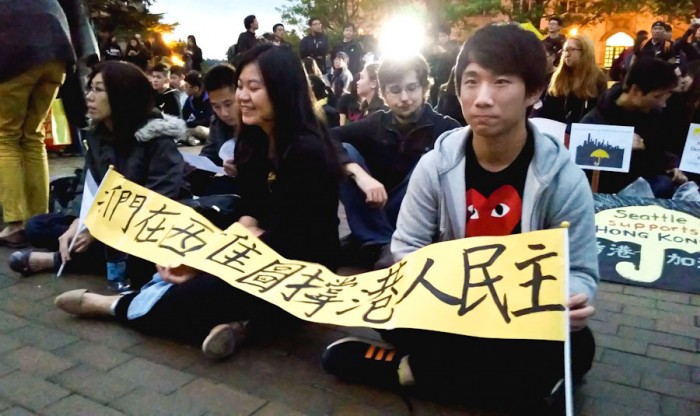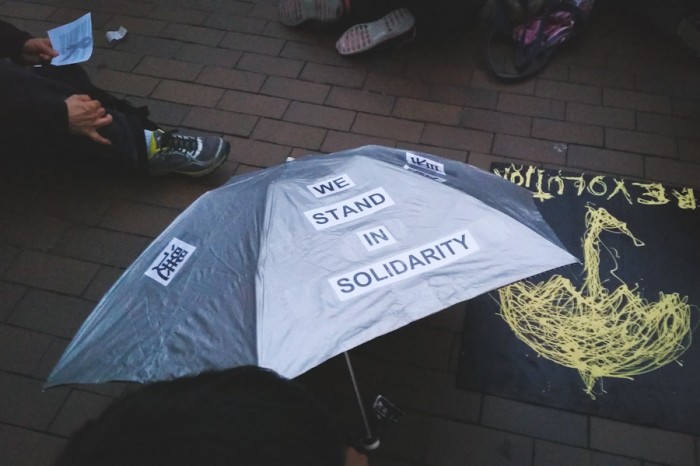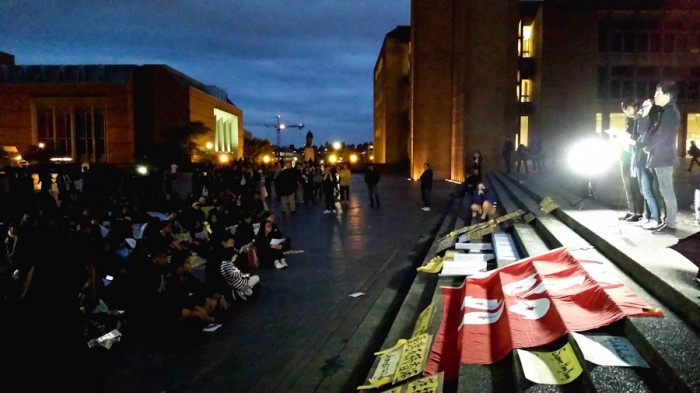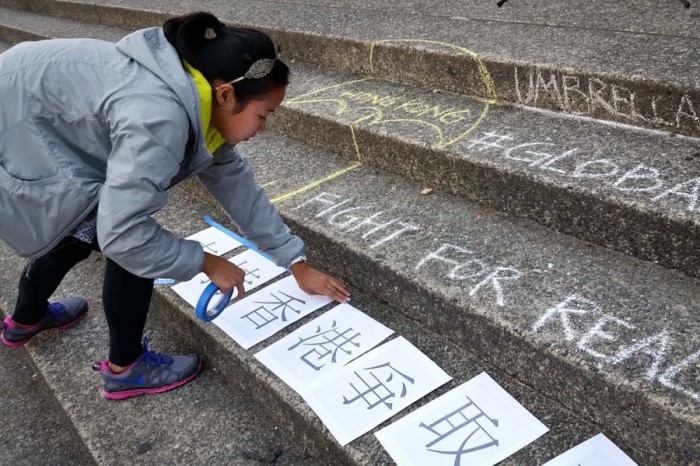
Seattle’s skies were clear on Wednesday night, but the University of Washington’s Red Square was a sea of umbrellas.
On the same day that Hong Kong’s history-making protests reached their highest numbers yet, over 250 students and community members gathered at UW to speak about Hong Kong’s protests, police brutality, and the meaning of “true” democracy.
Along with crowds in dozens of cities worldwide, they were standing in solidarity with the “umbrella revolution,” young Hong Kong’s standoff with the central Chinese government. The unprecedented protests started as a reaction to Beijing’s plans for Hong Kong’s 2017 election, which are at odds with previous promises for a fully democratic vote.
When Hong Kong police reacted to peaceful protesters with violence and pepper spray on Sunday, the fifth day of the protests, the movement gained its trademark symbol: the umbrella, used to ward off pepper spray and symbolize the central Chinese government’s overarching “umbrella” of power.
Organizers in Red Square on Wednesday emphasized awareness of not only Hong Kong’s fight for democracy, but also the safety of protesters.
“I’m here for the safety of my friends and people in Hong Kong,” said Sophia Lo, a UW junior from Hong Kong.
The Beijing government has called the protests illegal, and has endorsed the police’s response. Rather than escalate confrontations with protestors, however, the central Chinese government is now “waiting the protests out.” As key areas of Hong Kong remain shut down under “Occupy Central,” one name of the movement, Beijing is counting on the protests to fizzle out.

Some, both in Hong Kong and in communities in Seattle, are unsure about the efficacy of mass protests, and question its effect on Hong Kong’s economy.
“I think Hong Kong people’s desire for democracy is clear, but there’s disagreement about how to get there,” said UW immunology postdoc Quan Chao. “The older generation — including my mom, probably — they’re shaking their heads, saying that this [civil disobedience] won’t work. But the students are standing up. We need to say something.”
The “Occupy” in “Occupy Central” is not used in the anti-capitalist, “Occupy Wall Street” sense of the term. Rather, it voices a demand specific to Hong Kong, with universal suffrage as the ultimate vision and the resignation of Hong Kong’s current, Beijing-friendly chief executive C. Y. Leung as the immediate goal.
This confrontation has been building up for decades, since the UK handed Hong Kong, one of its last imperial possessions, to the Chinese government in 1997. Under a “one country, two systems” deal, Hong Kong has preserved its own legal system, civil liberties, and a high degree of autonomy. Part of this deal was a promise for “universal suffrage” — that is, democratic elections by the people of Hong Kong of Hong Kong’s top leader, the chief executive, in 2017. Until then, the chief executive would be appointed by a pro-Beijing committee.
The umbrella revolution ignited in response to Beijing’s recent announcement that it would actually hand-pick the candidates to appear on the 2017 ballot. While citizens will be able to vote, the candidates will be appointed by a special committee — a committee not unlike the one that currently appoints the chief executive.

In a scathing speech drawing on Martin Luther King Jr. and constitutional expert Benny Tai, Grace Wong, a UW exchange student from Hong Kong University, told the crowd at UW, “It’s like if your mom says that you’re free to choose a boyfriend, but you have to choose from these two ugly boys.”
This latest chapter of Hong Kong’s struggle for democracy has implications far beyond Hong Kong. Protesters’ reactions to police brutality have conjured comparisons to the “hands up don’t shoot” stance of protesters in Ferguson.
“They are still stigmatized as rioters, or as people who are stopping the economic growth of Hong Kong. But you can see their response: they just hold up their hands,” said Jono Lee, a social worker from Hong Kong.
The event at UW also highlighted the parallels between Hong Kong and Taiwan, with several members of Seattle’s Taiwanese community showing solidarity.
“I really admire [the Hong Kong protesters’] courage,” said Yi-an Chen, a Taiwanese student who spoke about Taiwan’s Sunflower Movement. “The courage to stand up to the Beijing government, the courage to stand up for democracy.”
Ciwang Teyra, who identifies as indigenous Taiwanese, said, “We [members of the Taiwanese community] are coming from a student group — but today we are not using that name, because we are just individuals coming to support Hong Kong.”

Several regions of China were also represented at the event. One volunteer speaker, who identified as coming from Northeastern China, said, “You’re not the only ones disappointed with what’s happened.”
Perhaps most striking are the comparisons between Hong Kong’s current protests and the Beijing movements of 1989. Tina Choi, one of the event’s organizers, said, “We don’t know how this will end, but we don’t want another Tiananmen Square.”
This highlights the scope of Hong Kong’s protests, with implications far beyond the terms of the 2017 elections. This latest movement calls into question the future of Hong Kong’s relationship with the central Chinese government.
“I’m 34 years old, and I really want to see universal suffrage happen in my lifetime,” said Lake Lui, a sociology PhD student from Hong Kong and an organizer of the event. “My grandparents, my parents cannot see this happen — but I really hope that at least in my generation, or maybe in the next generation, we can see this.”


>>>
中環地方
每逢主日
車水馬龍
甚少出現
為何此日
平靜不再
車輛不多
人卻湧現
護法守紀
專業人仕
擎槍相向
所為何事
手無寸鐵
同根市民
莘莘學子
淚流體傷
我主我神
恩臨香港
創傷治癒
傷口撫平
睡醒明天
轉機處處
和平共處
重現這城
阿們
written on Sunday night after tear gas
Thank you for sending this! Would you or someone you know be willing to provide an English translation?